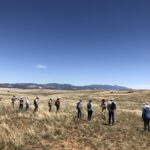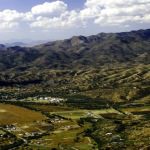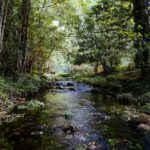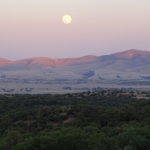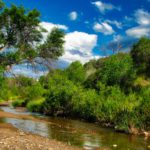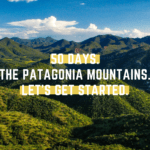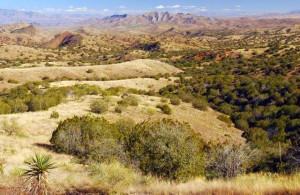
Mar 6, 2015 | Blog
ADEQ decision ruled “not supported by evidence” and “an abuse of discretion”
Save the Scenic Santa Ritas Media Release
(Phoenix, Ariz.) A Maricopa County (AZ) Superior Court today overturned a key air pollution permit for Toronto-based Hudbay Minerals’ proposed Rosemont copper mine. Judge Crane McClennen ruled the Arizona Department of Environmental Quality (ADEQ) acted “contrary to law” in its January 2013 decision to issue Rosemont the permit.
In completely adopting the evidence and arguments presented by SSSR, the court found the state relied on flawed data provided by Rosemont that was designed to understate the air pollution impact of the proposed $1.5 billion open pit copper mine.
McClennen stated in his ruling that ADEQ’s decision to issue the permit “was arbitrary and capricious,” an “abuse of discretion,” and “not supported by substantial evidence.”
The ruling came in response to a lawsuit filed by Save the Scenic Santa Ritas (SSSR), a southern Arizona coalition opposing the mine. SSSR provided evidence that Rosemont had manipulated its data in an attempt to convince ADEQ that pollution from the mine would not violate applicable air quality and health standards. SSSR showed if appropriate modeling were used, Rosemont’s operations wouldindeed violate these standards.
“Rosemont has a long history of playing fast and loose with the facts,” said Gayle Hartmann, SSSR’s President. “They expect ADEQ and other regulatory agencies to just rubber stamp their projects, but this time they both got caught. The court agreed with us that ADEQ did not do an adequate and proper job of evaluating Rosemont’s application.

Proposed Rosemont Copper Mine Site. Photo courtesy Arizona Mining Reform Coalition.
Rosemont is seeking state and federal permits to blast a massive open pit copper mine in the Santa Rita Mountains on the Coronado National Forest near Tucson. The air pollution permit is one of the several permits that Hudbay needs, but still doesn’t have, before it can begin operations at the mine site.
Today’s ruling means ADEQ will have to re-evaluate the air permit in light of additional data and analysis presented by SSSR showing the mine would violate state air quality and health standards.
At a hearing before an Administrative Law Judge last year, air quality experts working with SSSR provided evidence revealing that Rosemont selected an extremely low data measurement threshold for its ADEQ permit application in a manipulative attempt to show that mine operations would not exceed air quality standards.
Rosemont also did not tell ADEQ that it had provided data to the U.S. Forest Service, at that agency’s request, showing that using even a slightly higher measurement threshold would cause the mine to violate air quality standards. SSSR emphasized the significance of the report to the Forest Service proving that violations would occur.
Attorneys for Rosemont acknowledged to Judge McClennen in January that the company provided ADEQ with air pollution data that was substantially different than what the company gave to the U.S. Forest Service.
In particular, Rosemont chose to use a 5% ratio of nitrogen dioxide to nitrogen oxide pollution in its air pollution model, even though it had no hard data proving that 5% was the appropriate ratio to use. In fact, Rosemont had looked at how much pollution would be emitted using ratios of 5%, 10%, and 30%, but decided to give ADEQ only the 5% data results – the only level not showing a violation of air quality and public health standards.
By comparison, the Environmental Protection Agency, which oversees the Clean Air Act, recommends a default ratio of 50% when, as here, there is no hard data supporting a lower ratio.
“Rosemont can’t have it both ways,” said local physician Dr. Tom Purdon who also sits on the SSSR Board of Directors. “They tell the Forest Service one thing and then tell ADEQ something very different. What that tells southern Arizonans is that Rosemont still can’t be trusted. And it’s our health that would be jeopardized if the mine violates air quality standards.”
The Court ruling can be downloaded here.
Save the Scenic Santa Ritas is a non-profit organization working to protect the Santa Rita and Patagonia Mountains from environmental degradation caused by mining and mineral exploration.


Feb 13, 2015 | Blog
FOR IMMEDIATE RELEASE
Regional Forester Issues Time Critical Removal Action Approval Memo
Patagonia, Arizona – Yesterday, the Southwestern Regional Office of the US Forest Service issued an Action Memo for “Time Critical” clean up of the abandoned Lead Queen mine in the Patagonia Mountains on the Coronado National Forest, approximately 6 miles south of the town of Patagonia, Arizona.
Members of the Patagonia Area Resource Alliance (PARA) discovered the abandoned mine over-flowing with toxic, orange sludge into a tributary of Harshaw Creek, last September. PARA documented the spill and notified authorities. The Harshaw Creek tributary eventually flows into the Town of Patagonia, Sonoita Creek and Patagonia Lake.
As the land owners of the Lead Queen mine, the Forest Service was issued two Notice of Violations from the Arizona Department of Environmental Quality: “Addition of a pollutant to navigable waters from a point source without a permit,” and “Discharge of storm water associated with an industrial activity without a permit.”
 Test results showed off-the-chart concentrations of lead and arsenic in water, soil and waste rock samples at the Lead Queen site. High concentrations of zinc, copper and aluminum were also found. All of these heavy metals are listed as “hazardous substances” and can cause serious – or even deadly – health issues. The red-orange color of the sludge was due to extreme concentrations of iron.
Test results showed off-the-chart concentrations of lead and arsenic in water, soil and waste rock samples at the Lead Queen site. High concentrations of zinc, copper and aluminum were also found. All of these heavy metals are listed as “hazardous substances” and can cause serious – or even deadly – health issues. The red-orange color of the sludge was due to extreme concentrations of iron.
The USFS document stated the clean up aims to reduce potential exposure of the hazardous heavy metals to “human populations, animals or the food chain.”
“This is a good start, but I’ve seen many more abandoned mines in the Patagonia Mountains that also need to be cleaned up. The mining industry has a well-earned reputation for just walking away from mines when they’re done.” Gooch Goodwin, native Patagonian and PARA board member.
 The Forest Service document also acknowledges that the “Patagonia Mountains have high levels of biodiversity and are home to a variety of species protected under the Endangered Species Act including jaguar, ocelot, lesser long-nosed bat, Mexican spotted owl, western yellow-billed cuckoo, Sonora tiger salamander, and the northern Mexican gartersnake.”
The Forest Service document also acknowledges that the “Patagonia Mountains have high levels of biodiversity and are home to a variety of species protected under the Endangered Species Act including jaguar, ocelot, lesser long-nosed bat, Mexican spotted owl, western yellow-billed cuckoo, Sonora tiger salamander, and the northern Mexican gartersnake.”
It additionally states, “the area is best-known and most popular places for birding in the U.S. Bird enthusiast who come from all over the world to catch a glimpse of more than 300 species of birds, including many Neotropical species that migrate, nest, and live in this unique habitat.”
Clean up of the five acre site is expected to start Spring 2015 and be completed before the coming monsoon season to avoid erosion and flushing of heavy metals further downstream.
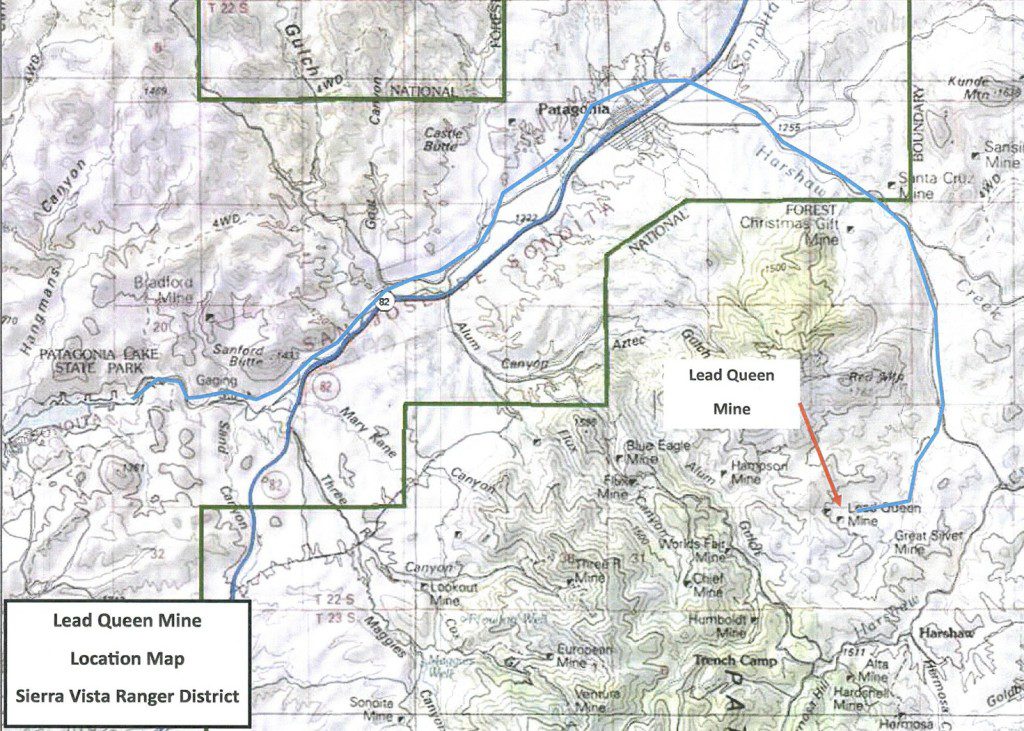
USFS map of Lead Queen mine location
Read USFS Lead Queen Mine Removal Action Memorandum
For further information regarding the USFS Removal Action Memorandum, please contact Eli Curiel, P.E., On-Scene Coordinator, at 520-388-8413; or Maria McGaha, P.E., Regional Environmental Engineer, at 505-842-3837.
###
The Patagonia Area Resource Alliance is a citizen watchdog organization that monitors the activities of mining companies, as well as ensures government agencies’ due diligence, to make sure their actions have long-term, sustainable benefits to our public lands, our water, and the town of Patagonia. For more information visit www.patagoniaalliance.org and follow us on Twitter @PARAalliance.

Jan 13, 2015 | Blog
FOR IMMEDIATE RELEASE
Plug Pulled on Proposed “Sunnyside” project in Arizona’s Coronado National Forest
Tucson, Ariz. — Today the U.S. Forest Service temporarily put the brakes on an environmentally hazardous mining project in southern Arizona’s Coronado National Forest that it previously approved in August. The Forest Service’s decision follows a similar move by the U.S. Fish and Wildlife Service, which had originally given the project the green light in August and then withdrew its approval in December. The agency decisions to withdraw their approvals of the Canadian mining company Regal Resources’ “Sunnyside Project” are based on the project’s potential violation of multiple environmental laws.

photo by Nathan Rupert
“The agencies knew from the beginning that this project could have a devastating impact on the local wildlife and habitat in this unique corner of the country,” said Rob Peters of Defenders of Wildlife. “The Coronado is home to an incredible diversity of imperiled species like the jaguar, ocelot and yellow-billed cuckoo, all which are already at risk from multiple projects in the region.”
“No one understood why they approved this project to begin with, but for the sake of Patagonia’s residents and wildlife, we are glad to see that they’ve reconsidered,” added Peters.
In October conservation groups Defenders of Wildlife and the Patagonia Area Resource Alliance filed a lawsuit claiming the federal agencies’ approvals the Sunnyside project violated environmental laws and posed a threat to endangered species and the safety of drinking water for local residents.
“Sunnyside could have been a disaster not only for our region’s unique wildlife, but also for the residents living directly downstream and the municipal watershed of the town of Patagonia,” said Wendy Russell of the Patagonia Area Resource Alliance. “Projects like Sunnyside use and abuse a tremendous amount of the local water supply and create long-term destruction of wildlife habitat. The people and wildlife of our national forests deserve more, and the agencies know that.”
Click to hear from environmental attorneys on why they sue.
###
Contact: Courtney Sexton, csexton@defenders.org, 202-772-0253
Wendy Russell, wendy@patagoniaalliance.org, 520-477-2308
Defenders of Wildlife is dedicated to the protection of all native animals and plants in their natural communities. With more than 1.1 million members and activists, Defenders of Wildlife is a leading advocate for innovative solutions to safeguard our wildlife heritage for generations to come. For more information, visit www.defenders.org and follow us on Twitter @DefendersNews.
The Patagonia Area Resource Alliance is a citizen watchdog organization that monitors the activities of mining companies, as well as ensures government agencies’ due diligence, to make sure their actions have long-term, sustainable benefits to our public lands, our water, and the town of Patagonia. For more information visit www.patagoniaalliance.org and follow us on Twitter @PARAalliance.
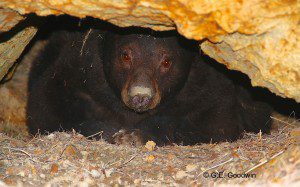
Dec 28, 2014 | Blog
The AZ Mining Inc (Wildcat Silver) Hermosa drilling project timeline was just pushed back–now almost a full year behind the previous schedule. We couldn’t have planned a better holiday gift! The release of the Hermosa Environmental Assessment (EA) and Draft Decision is now estimated for July 2015, which would then trigger a 45 day deadline for objections. If you commented on the Hermosa project, you will be able to participate in the objection process. PARA has successfully delayed AZ Mining Inc / Wildcat Silver–and all other mining companies–from drilling on public land in the Patagonia Mountains since 2011.
Your Gift is Helping to Save Wildlife and Water in Patagonia!

Save my home in the Patagonia Mountains. ©Gooch Goodwin
Billie the Black Bear makes her home in the Patagonia Mountains. Open pit mining would destroy her home and the water that we all depend upon. Your gift to the Patagonia Area Resource Alliance empowers us to keep new mining activity off of public land in the Patagonia Mountains–successfully since 2011!
Read more about our most recent Activities and Accomplishments.
Your donations also make it possible for us to organize community involvement and action so that we can protect the Patagonia Mountains, wildlife and habitats, our waterways and our communities.
Please consider making a donation to PARA this year to support and grow this critical work in the Patagonia Mountains: patagoniaalliance.org/donations/
A big thank you to everyone who has already donated this year!
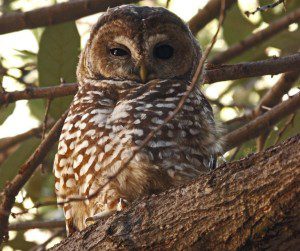
Mexican Spotted Owl © Glen E Goodwin
PARA Taking Action
The Forest Service approved the Sunnyside mineral drilling proposal by Regal Resources in the Patagonia Mountains, even though it directly threatens the imperiled Mexican spotted owl in the most sensitive area of their habitat–their roosting and nesting areas. As a result, we filed suit in federal court with Defenders of Wildlife for that unlawful approval, which violates environmental laws and poses potential threats to additional endangered species and the safety of drinking water for local residents.
Even More Good News: Thank You PARA Supporters!
We are very fortunate to have a group of amazingly committed community members and generous donors supporting our work.
We’ve just exceeded our year-end goal of raising $19,000! We on our way to reaching our entire 2015 operating budget. Thank you!
The work necessary to keep mining out of the Patagonia Mountains a reality is only possible because of your financial support.
Consider making an automatic, monthly donation to PARA on your credit card through PayPal.
Every single contribution makes a sizable difference to our organization and ultimately for our community.
It is only because of the generous support from people like you that we can undertake this critical work. Thank you!

Nov 26, 2014 | Blog
It’s hard to believe that the end of the year is nearly upon us! When 2014 began, your friends, neighbors and colleagues here at the Patagonia Area Resource Alliance (PARA) were gearing up for a busy year promoting the incredible beauty, community, and natural heritage of the Town of Patagonia and the Patagonia Mountains. Little did we know what a whirlwind year it would be! The past eleven months have seemingly sped by while we have been advocating to protect this amazing place that we all treasure from the multiple threats that exploratory drilling and mining pose to our small community.
PARA was formed in 2011 to educate and engage the community about the risks and realities of mining, to promote local sustainable economies, to better understand our precious and imperiled natural resources such as clean water and wildlife, and to actively advocate for the protection of those resources in concert with Patagonia’s distinct and serene rural way of life.
You have helped us along the way this year! You have volunteered, come to public meetings, wrote letters, monitored wildlife, and participated in the NEPA process. Together, we have contributed over 2500 volunteer hours already in 2014!
It has been another amazing and transforming year for PARA, but we have so much more to do! PARA runs on a shoestring budget with the human power of an almost entirely volunteer workforce and our two person outreach team–budgeted for only 30 hours per week. We’d like to do so much more! Please consider making a donation to PARA this year to support and grow this critical work in our community.
A few of the activities and accomplishments reached this year through the contributions of all of PARA’s supporters, volunteers and partners:

Ocelot, Leopardus pardalis. photo US FWS
Holding Agencies Accountable
Filed a complaint in federal court in October with Defenders of Wildlife against the Forest Service and the Fish and Wildlife Service for their unlawful approval of the Regal Resources Sunnyside mineral drilling project in southern Arizona’s Coronado National Forest, in the Alum Gulch area of the Patagonia Mountains. The Sunnyside project approval violates environmental laws and poses a potential threat to endangered species and the safety of drinking water for Patagonia area residents. The Coronado National Forest, Patagonia Mountains and waterways in our region support some of the world’s most imperiled wildlife, including jaguar, ocelot, lesser long-nosed bat, Mexican spotted owl, and yellow-billed cuckoo.
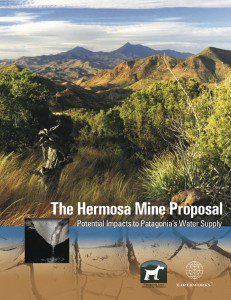 Educating the Community on Mining Risks
Educating the Community on Mining Risks
Released a peer-reviewed report with the national organization EARTHWORKS, “The Hermosa Mine: Potential Impacts to Patagonia’s Water Supply.” The report uses geologic and hydrologic studies from mine developer AZ Mining Inc (Wildcat Silver), the United States Geologic Survey, the Arizona Department of Water Resources, the Town of Patagonia, and others, as well as analyzes historic contamination issues caused by mining in the Patagonia Mountains. We conclude in our report that the seemingly inescapable realities of acid drainage and water consumption impacts pose too great a risk to Patagonia.
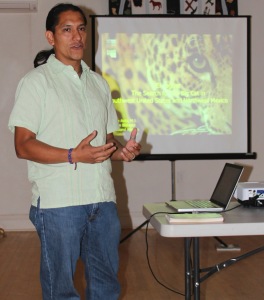
SIA Biologist, Sergio Avila
Empowering the Community, Ensuring Due Diligence
Coordinated and submitted NEPA comments on the USFS draft Environmental Assessment for the AZ Mining Inc (Wildcat Silver) Hermosa drilling project with Defenders of Wildlife, Arizona Mining Reform Coalition, Center for Biological Diversity, Earthworks, and Sky Island Alliance. Hosted a community workshop to empower residents to comment on the Hermosa EA comprising of an overview of the Hermosa proposal and its likely impacts; a NEPA presentation and how to comment on an EA by Jenny Neeley, Attorney at Law; and a presentation of area wildlife by Biologist, Sergio Avila, of Sky Island Alliance.

Sonoita Creek
Tireless Advocacy for Patagonia Area Water and Wildlife
Submitted comments regarding the proposed United States Forest Service Guidelines on Groundwater, advocating for groundwater protection and consideration of potential impacts regarding all agency activities in our National Forests, especially in regards to hardrock mining. Submitted comments to the Environmental Protection Agency regarding the proposed rule defining the “Waters of the U.S.” advocating for protection of ephemeral and intermittent streams. Submitted comments advocating for more designated critical habitat in the Patagonia Mountains for the threatened yellow-billed cuckoo.
To learn more about our 2014 accomplishments and efforts, please take a look at PARA’s “Report to the Community” available on our website at: www.patagoniaalliance.org/our-activities- outreach/
Looking Ahead…
Unceasing Protection of the Patagonia Mountains.
With continued legal assistance from Defenders of Wildlife, PARA strives to hold mining companies, the US Forest Service and all agencies accountable to follow the laws and regulations designed to protect our water, air, surrounding ecosystems and communities. We are positioned to respond to future exploratory mining proposals scheduled for the Patagonia Mountains.
Sustaining Wildlife Data Documentation and Collaborations
Citizen scientists from the community continue wildlife monitoring efforts in the Patagonia Mountains focusing on areas immediately at risk by proposed mining activities. Data gathered is used to fight mining proposals through species lists, presence of vulnerable species and habitat analysis. Additional collaborations are ongoing with Defenders of Wildlife, EARTHWORKS, Sky Island Alliance and Tucson Audubon to ensure this data is applied to advocacy efforts in the most effective ways.
Increasing Our Outreach for 2015
PARA is strategizing to expand community education activities to grow our base of support and empower concerned residents with potential actions to keep mining out of the Patagonia Mountains. We recognize the need to establish sustainable funding to maintain core functions and seek to expand funding sources. With our additional staff funding in the 2015 budget, we plan to sustain our two person team to continue to expand our outreach beyond our community boundaries. Our 2014 Financial Report is also available online: www.patagoniaalliance.org/our-activities-outreach/
For A Thriving Community in 2015 and beyond
PARA recognizes that the health and economic prosperity of our community are deeply connected to the well-being of the Patagonia Mountains and the Harshaw/Sonoita Creek watershed. They are the source of our drinking water, clean air and the centerpieces that drive our local economy.
Please make a Year-End Gift to PARA
There are many needs in our community and many compelling requests for support. We believe one of the most fundamental is protecting our drinking water and our community from the well-known detrimental effects of open pit mining. To that end, PARA is seeking to raise $19,000 by the end of 2014 to support the several ongoing and new initiatives outlined above as we move into 2015. We are fortunate to have a group of amazingly committed community members and generous donors supporting our work, but we are looking to broaden the base of support to ensure not only financial sustainability, but also the ability to impact local, regional and national decision-making on our own behalf.
That’s where you come in. The work necessary to make this vision of 2015 a reality is possible only because of your time and your financial support. Please make a gift today.
Recurring monthly donations can be made securely through PayPal.
Every single contribution makes a sizable difference to our organization and ultimately for our community. It is only because of the generous support from people like you that we can undertake this critical work. Thank you!
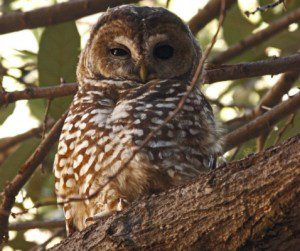
Oct 29, 2014 | Blog
FOR IMMEDIATE RELEASE
October 29, 2014
Contact: Courtney Sexton, csexton@defenders.org, 202-772-0253
Wendy Russell, wendy@patagoniaalliance.org, 520-477-2308
Groups file complaint against Forest Service and Fish and Wildlife Service for approval of mineral drilling project in Arizona’s Coronado National Forest
TUCSON, ARIZ. – Defenders of Wildlife and the Patagonia Area Resource Alliance today asked a federal court to hold the United States Forest Service and United States Fish and Wildlife Service accountable for their unlawful approval of the “Sunnyside” mineral exploration drilling project in southern Arizona’s Coronado National Forest, in the Alum Gulch area of the Patagonia Mountains. The groups say the approval of the Canadian mining company Regal Resources’ Sunnyside Project violates environmental laws and poses a potential threat to endangered species and the safety of drinking water for local residents. The Sunnyside Project involves drilling multiple exploratory holes up to 6,500 feet deep in one of the most biologically diverse mountain ranges in Arizona. The extensive drilling and construction would run 24/7 for months on end, and the total project operations could last up to 3 years.

Mexican spotted owl, ©Gooch Goodwin
The Coronado National Forest, the Patagonia Mountains and the watersheds in this region support some of the world’s most imperiled wildlife, including the jaguar, ocelot, lesser long-nosed bat, Mexican spotted owl, and yellow-billed cuckoo. Of particular concern is the Mexican spotted owl “Protected Activity Center” (PAC) in the Alum Gulch area, a site which is supposed to have the greatest protection of the law. One of the project’s proposed drilling sites is only one-tenth of a mile from the “nesting core area” of this PAC.
“The potential damage from the Sunnyside Project, especially coupled with other damaging mining projects in the region, could have devastating impacts on this imperiled wildlife and the habitat they depend on, as well as the water supply for local residents,” said Rob Peters of Defenders of Wildlife. “This is a national forest and imperiled wildlife and their habitats on the forest should be protected— not polluted by expanded drilling operations.”

Ocelot, Leopardus pardalis. photo US FWS
Patagonia area residents are dependent on water originating from Alum Gulch, an area which is also designated as critical habitat for the jaguar and Mexican spotted owl. The imperiled ocelot, lesser long-nosed bat, and yellow-billed cuckoo have also been observed near the project area.
“The Sunnyside Project could have tremendous adverse impacts on local wildlife and local residents, affecting the floodplains and the municipal watershed of the town of Patagonia,” said Wendy Russell of the Patagonia Area Resource Alliance. “The drilling will require 12,500 gallons of water per day, an amount approximately equal to ten percent of the daily water usage of the Town of Patagonia. This project threatens not only endangered wildlife, but our community’s water, health and safety.”
Click to hear from environmental attorneys on why they sue.
###
Defenders of Wildlife is dedicated to the protection of all native animals and plants in their natural communities. With more than 1.1 million members and activists, Defenders of Wildlife is a leading advocate for innovative solutions to safeguard our wildlife heritage for generations to come. For more information, visit www.defenders.org and follow us on Twitter @DefendersNews.
The Patagonia Area Resource Alliance is a citizen watchdog organization that monitors the activities of mining companies, as well as ensures government agencies’ due diligence, to make sure their actions have long-term, sustainable benefits to our public lands, our water, and the town of Patagonia. For more information visit www.patagoniaalliance.org and follow us on Twitter @PARAalliance.
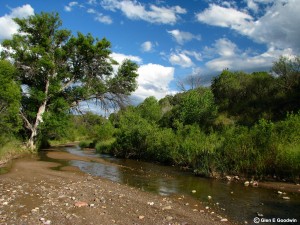
Oct 28, 2014 | Blog
Peer-reviewed report outlines Hermosa mine’s risks of water consumption, perpetual water pollution to Patagonia area
Patagonia Area Resource Alliance
Earthworks
October 28, 2014
 Patagonia – The Hermosa silver mine proposed inside Patagonia, Arizona’s Municipal Supply Watershed could deplete the town’s drinking water and perpetually contaminate area groundwater with acid mine drainage, according to a new peer-reviewed report.
Patagonia – The Hermosa silver mine proposed inside Patagonia, Arizona’s Municipal Supply Watershed could deplete the town’s drinking water and perpetually contaminate area groundwater with acid mine drainage, according to a new peer-reviewed report.
Reviewed* by a USGS scientist and released by the Patagonia Area Resource Alliance and Earthworks, the study also concludes that drinking water wells of surrounding residents are also threatened.
“A mine that threatens our town’s drinking water is a mine that shouldn’t be built,” said Wendy Russell of the Patagonia Area Resource Alliance. She continued, “In Arizona, water is more precious than silver, and especially so after more than a decade of drought.”
Proposed by Canadian exploration company AZ Mining Inc (Wildcat Silver) – a company with no experience operating a mine – Hermosa is proposed at a time when Patagonia is already concerned with dropping groundwater levels and increasing concern about future water supplies.
The 4,000 foot wide and 1,500 foot deep Hermosa silver and manganese mine would consume 670 million to 1.2 billion  gallons of groundwater per year – up to 53 times the amount of water the town uses today — to run the mine within the upper reaches of Harshaw Creek, a portion of Patagonia’s Municipal Supply Watershed. This water consumption will lower the recharge rates for the aquifer on which the town depends, and is also likely to produce acidic runoff, requiring ongoing treatment in perpetuity.
gallons of groundwater per year – up to 53 times the amount of water the town uses today — to run the mine within the upper reaches of Harshaw Creek, a portion of Patagonia’s Municipal Supply Watershed. This water consumption will lower the recharge rates for the aquifer on which the town depends, and is also likely to produce acidic runoff, requiring ongoing treatment in perpetuity.
“If the U.S. Forest Service were to permit the Hermosa mine, this report shows it would jeopardize our community’s drinking water. And for what? For foreign shareholders’ silver,” said Wendy Russell. She continued, “This is a mine proposal that just doesn’t make sense for our community who would actually have to live with it.”
The mine is proposed within the Coronado National Forest, and therefore subject to the 1872 Mining Law. Federal land managers interpret the 1872 Mining Law to require them to permit mines, no matter if the land is better used for other purposes – like protecting a town’s drinking water supply watershed.
“Because the Hermosa mine proposal threatens area water supplies, it obviously should not be permitted,” said report author Pete Dronkers of Earthworks. He continued, “That it’s being considered at all is a strong argument for reforming the 1872 Mining Law to allow the consideration of other potential land uses.”
The report also evaluates the nature of groundwater depletion that is likely under the proposed mine plan, characterizes the impacts of such, and also analyses other known adverse impacts, such as air pollution, endangered species, and other cumulative impacts.
The report, including an executive summary, can be found at: patagoniaalliance.org/report-hermosa-mine
For more information:
Fact Sheet
Full Report
Contact:
Pete Dronkers, Earthworks
(775) 815-9936, pdronkers@earthworksaction.org
Wendy Russell, Patagonia Area Resource Alliance
(520) 477-2308, wendy@patagoniaalliance.org
* An earlier version of this press release indicated that a USGS scientist “endorsed” this report. We were informed by the United States Geological Survey that the agency only endorses their own reports and documents.

Oct 8, 2014 | Blog
For Immediate Release
U.S. Fish and Wildlife Service
October 02, 2014
Sacramento – The western population of the yellow-billed cuckoo will be protected as a threatened species under the Endangered Species Act (ESA), the U.S. Fish and Wildlife Service announced today. The Service determined that listing a distinct population segment (DPS) of the bird in portions of 12 western states, Canada and Mexico is warranted. In the U.S., the DPS will cover parts of Arizona, California, Colorado, Idaho, Nevada, New Mexico, Texas, Utah, Wyoming, Montana, Oregon and Washington.
 The western population of the yellow-billed cuckoo (Coccyzus americanus), an insect-eating bird found in riparian woodland habitats, winters in South America and breeds in western North America. Once abundant in the western United States, populations have declined for several decades, primarily due to the severe loss, degradation and fragmentation of its riparian habitat as a result of conversion to agriculture, dam construction, river flow management and riverbank protection. Overgrazing and invasive exotic plants have also contributed to declines.
The western population of the yellow-billed cuckoo (Coccyzus americanus), an insect-eating bird found in riparian woodland habitats, winters in South America and breeds in western North America. Once abundant in the western United States, populations have declined for several decades, primarily due to the severe loss, degradation and fragmentation of its riparian habitat as a result of conversion to agriculture, dam construction, river flow management and riverbank protection. Overgrazing and invasive exotic plants have also contributed to declines.
“While the major threat to yellow-billed cuckoos has been loss of riverside habitat, we do not anticipate any significant new water-related requirements as a result of this listing decision,” said Ren Lohoefener, Director of the Service’s Pacific Southwest Region. “The water resource requirements for riparian habitat are not unique to cuckoos, and in many cases are already being implemented for other species. Riparian restoration efforts go hand-in-hand with good land management, especially management that promotes good livestock grazing practices.”
The Service’s final listing rule, which will be published in tomorrow’s Federal Register and become effective November 3, 2014, is based on a thorough review of the best scientific and commercial information available, obtained through exhaustive research, public comments and independent scientific peer reviews.
Next steps include designation of critical habitat for the species and development of a recovery plan. Both steps will be strengthened by participation from other federal and state agencies, tribal entities and the public in the open comment periods.
More information, including the listing rule, is at: http://www.fws.gov/sacramento/outreach/Public-Advisories/WesternYellow-BilledCuckoo/outreach_PA_Western-Yellow-Billed-Cuckoo.htm
Proposed Critical Cuckoo Habitat Near Patagonia, Arizona.
Critical habitat for the Yellow-billed cuckoo is proposed from the Town of Patagonia west along Sonoita Creek and includes Patagonia Lake and the Sonoita Creek State Natural Area. That area is the only proposed critical habitat near Patagonia, Arizona. The effect of this regulation, if finalized, is to designate critical habitat for the western yellow-billed cuckoo under the Endangered Species Act.
FWS is seeking comments on the designation of critical habitat for Western Yellow-billed cuckoos. Deadline to comment is October 14, 2014.
Follow link to submit comments: https://www.federalregister.gov/articles/2014/08/15/2014-19178/endangered-and-threatened-wildlife-and-plants-designation-of-critical-habitat-for-the-western
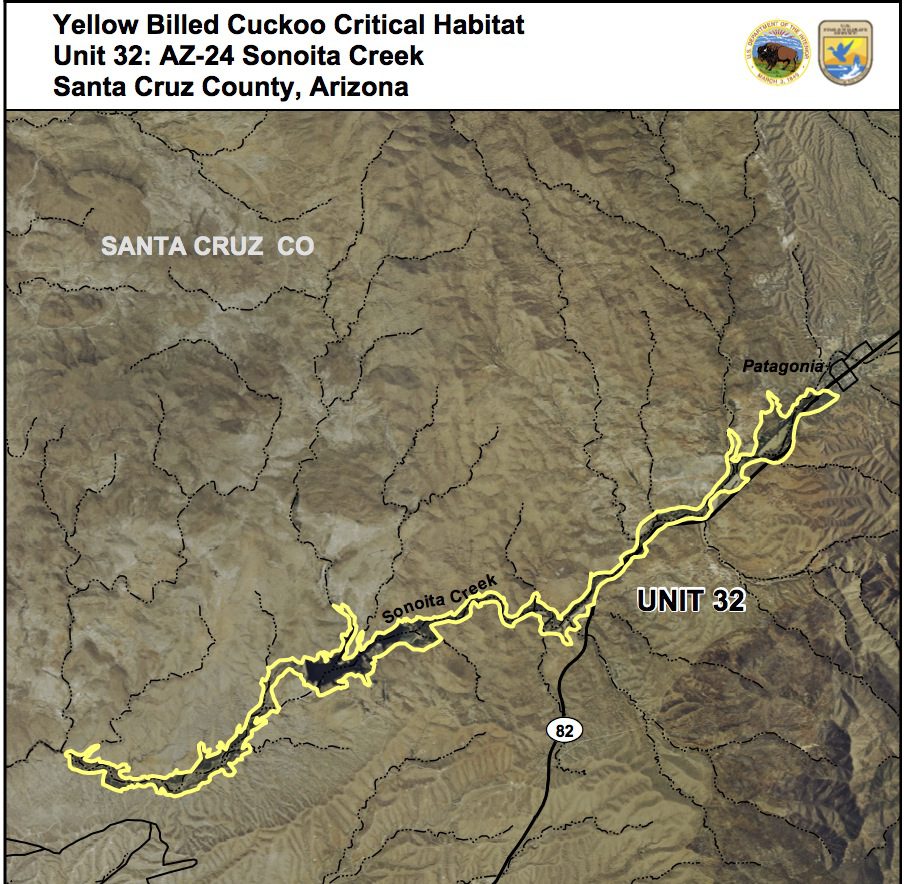
Sonoita Creek Cuckoo Proposed Habitat: Unit 32_AZ_24
The mission of the U.S. Fish and Wildlife Service is working with others to conserve, protect, and enhance fish, wildlife, plants, and their habitats for the continuing benefit of the American people. We are both a leader and trusted partner in fish and wildlife conservation, known for our scientific excellence, stewardship of lands and natural resources, dedicated professionals, and commitment to public service. For more information on our work and the people who make it happen, visit www.fws.gov/mountain-prairie.
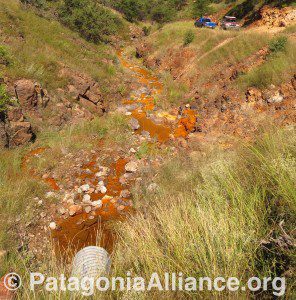
Sep 26, 2014 | Blog
FOR IMMEDIATE RELEASE
Contact: Courtney Sexton, 202.772.0253, csexton@defenders.org
Wendy Russell, 520.477.2308, Wendy@PatagoniaAlliance.org
Toxic Mining Contaminants Threaten People and Wildlife in Arizona

Bright orange water overflowing from the historic Trench mine, twice reclaimed by Asarco and now owned by the State of Arizona.
TUCSON, ARIZ. – Contaminants from a mine spill in Cananea, Sonora earlier this summer have likely reached the San Pedro River flowing into Arizona. And with recent storms, old copper and silver mine sites near Patagonia are leaking bright red contaminants into local streams. These toxic reminders of our mining history have the potential to wreak havoc on local water supplies and wildlife in the Coronado National Forest, one of the most biologically diverse areas in the world.
“The Coronado National Forest, the “Sacred” Santa Ritas, the San Pedro River Valley, the Patagonias and all of the Sky Islands nourish some of the most incredible and endangered biodiversity in the world, including jaguars, ocelots, yellow-billed cuckoos and Gila topminnows,” said Eva Sargent, director of Southwest Programs for Defenders of Wildlife. “This is a place that must be conserved, not a place for the destructive practice of mining and its toxic byproducts that ruin our public landscapes and pollute our waters.”
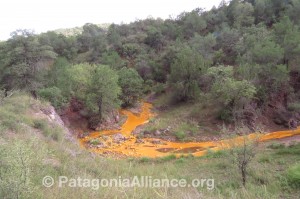
Toxic overflow from the historic Lead Queen mine in the Patagonia Mountains drains towards Harshaw Creek.
“All this toxic runoff is a prime example of why new mines should not be approved in the mountains of southern Arizona,” added Wendy Russell of the Patagonia Area Resource Alliance. “There are already approximately 130 abandoned mines in the Patagonia Mountains, many with eroding tailings and leaking tunnels discharging toxins. With heavy rainfall, that toxic discharge overflows into water systems like Harshaw Creek and Alum Gulch in the Santa Cruz watershed and threatens both local communities’ drinking water and already endangered fish and wildlife. With the state and federal governments seemingly incapable of cleaning up old polluting mines in the Patagonia Mountains, we have no confidence in their abilities to regulate new mining activity to protect our community’s drinking water, health and safety.”
Interviews with local experts regarding abandoned mine overflows in the Patagonia Mountains of southern Arizona in September, 2014.
###
Defenders of Wildlife is dedicated to the protection of all native animals and plants in their natural communities. With more than 1.1 million members and activists, Defenders of Wildlife is a leading advocate for innovative solutions to safeguard our wildlife heritage for generations to come. For more information, visit www.defenders.org<http://www.defenders.org/> and follow us on Twitter @DefendersNews<http://twitter.com/DefendersNews>.
The Patagonia Area Resource Alliance is a citizen watchdog organization that monitors the activities of mining companies, as well as ensures government agencies’ due diligence, to make sure their actions have long-term, sustainable benefits to our public lands, our water, and the town of Patagonia. For more information visit www.patagoniaalliance.org<http://www.patagoniaalliance.org>
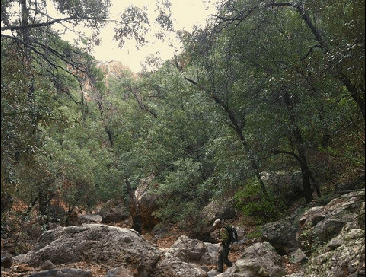
Sep 10, 2014 | Blog

Sierra Vista District Ranger Mark Ruggiero signed a Decision Memorandum (DM) for the Regal Resources Sunnyside exploratory mineral drilling project granting them a Categorical Exclusion and allowing a September 2014 start date. The project is located on the Coronado National Forest in Humboldt Canyon in the Patagonia Mountains and 6 miles south of the town of Patagonia, Arizona.
The Decision Memo followed a second round of scoping initiated in July 2013. “Seventy-eight comments were received during the 2013 30-day scoping period,” according to a August 28 email issued by CNF Geologist Patrick Morton. Scoping for this project also occurred in 2011. The Forest Service considered these prior comments for their analyses as well.
A Categorical Exclusion project is considered to NOT have a significant impact, either individually or collectively. It’s a category that is exempted from the National Environmental Policy Act (NEPA) requirements to prepare an Environmental Assessment or Environmental Impact Statement both of which would analyze potential impacts of a proposal.
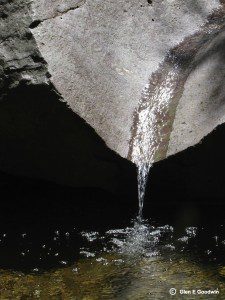
The potential negative effects that the Sunnyside drilling would have on the proposed Town of Patagonia Municipal Supply Watershed was one of the issues that raised by the Patagonia Area Resource Alliance. The Decision Memo (DM) states, “…the Town of Patagonia municipal supply may be affected. Due to the relatively limited duration and scale of the project, quantitative scientific studies have not been performed by the Forest Service regarding the water supply for the project and the possible effects to the town.” The DM concludes, “since the location of the water supply is unknown, the water supply of the Town of Patagonia may be totally unaffected as the supply source may be drawn from an entirely different groundwater basin.” We find this conclusion absurd.

Mexican Spotted Owl © Glen E Goodwin
PARA also submitted concerns about the Sunnyside drilling project’s effects on endangered species and their habitat. The DM stated that the Biological Assessment and Biological Evaluation determined that the drilling “‘may affect, not likely to adversely affect’ for jaguar, ocelot, lesser Long-nosed bat, and Mexican spotted owl.” The mineral drilling project is located in protected critical habitat for both the jaguar and the Mexican spotted owl.
Absent from the DM was any commentary on cumulative impacts in regards to Wildcat Silver’s Hermosa drilling proposal, other drilling proposals, other activity in the Patagonia Mountains, or ongoing drought conditions.
Regal Resources must post receipt of a reclamation bond, submit a final Plan of Operation with mitigations as required by the DM, and provide an approved spill response plan before their exploratory drilling can begin. Additionally, a September 3rd press release issued by Regal Resources begs the question if they even have the finances to start their exploratory drilling.
There is no objection period offered by the Forest Service for Categorical Exclusion (CE) decisions. CE decisions are final. Any appeals or objections must be addressed through litigation.
Questions about the Sunnyside drilling project should be directed to: Patrick Morton, Geologist, Coronado National Forest, 300 W. Congress St., Tucson, AZ 85701, 520-388-8348, pmorton@fs.fed.us.

Aug 8, 2014 | Blog

Save the Scenic Santa Ritas Media Release
August 8, 2014
Environmental Catastrophe in Canada Underscores Rosemont Threats
(TUCSON, Ariz.) The international engineering firm that designed a Canadian mine tailings dam that collapsed earlier this week is also playing a key role in the development of the proposed Rosemont Copper Mine’s tailings dump.
Monday’s catastrophic failure of Imperial Metal’s Mount Polley tailings dam sent millions of gallons of toxic slurry laden with heavy metals and other pollutants gushing into waterways approximately 370 miles northeast of Vancouver, BC. 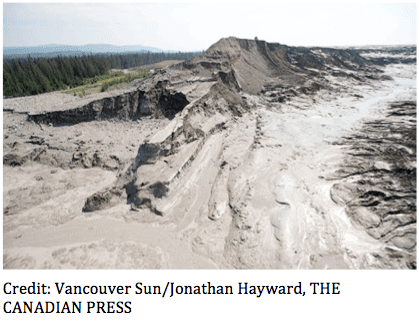
The Mount Polley environmental catastrophe has resulted in an emergency ban on drinking water, devastation of important salmon habitat and damage to the region’s tourism and outdoor economy. The costs of cleaning up the environmental damage are unknown, but the stock market apparently believes it will be significant, as Imperial Metals share price has dropped by over 40% since the incident occurred on Monday.
Knight Piésold Ltd. had provided Imperial Metals with design, construction supervision, quality control, and annual inspections of the failed Mount Polley tailings facility, according to Canadian regulatory filings.
In Arizona, Knight Piésold conducted laboratory testing on materials that would be used in Rosemont’s proposed tailings facility as a subcontractor for AMEC Earth & Environmental, Inc., which prepared the final design report for Rosemont’s dry stack tailings storage facility in April 2009.
AMEC also relied on Knight Piésold in 2010 to conduct analysis of soil materials in response to questions from the Arizona Department of Environmental Quality after it determined that the previous “assessment of physical and engineering properties of the dry stack tailings…is inadequate.”
“What happened in Canada this week is a reminder that, notwithstanding the PR spin from mining companies, the worst case scenario can and does happen,” said Gayle Hartmann, President of the Save the Scenic Santa Ritas. “While there may be some differences in the design, if even a fraction of the devastation that occurred in Canada were to take place at the proposed Rosemont mine, the drinking water supplies of a metropolitan area of 1 million people would be impacted not to mention the destruction of important desert riparian habitat.”
Potential incidents such as what occurred at the Mount Polley mine are the basis for SSSR’s repeated calls for the relevant regulatory agencies to do their job and reject the proposed Rosemont Mine because the risks to southern Arizona’s water supplies and economy are just too great. Earlier this year, a diverse group of organizations and individuals, including Save the Scenic Santa Ritas, Pima County, the Tohono O’odham Nation and Pascua Yaqui Tribe, and the Arizona Game and Fish Department, filed comprehensive written objections with the Forest Service on its final environmental analysis for the proposed mine.
Their objections raised a number of critical issues that, in light of the disaster in Canada, are even more relevant and significant today. These objections respond to the failure of the Forest Service to address the unmitigated toxic pit lake that will be created, accepting Rosemont’s and its engineers unproven assurances about the technical feasibility of its dry stack tailings which have never been used on a mine the size of Rosemont, allowing potential violations of the Clean Water and Clean Air acts and failing to set a specific amount for a reclamation bond that would clean up environmental disasters such as what occurred at Mount Polley.
“Given the revelation that the engineering firm that was involved in designing the failed tailings facility in Canada was also involved in the design of the Rosemont facility, the Forest Service must reverse its rubber stamp approval of the mine and along with the other regulatory agencies, reject the Rosemont mine to ensure that what happened in Canada will not happen here,” Hartmann said. “There are some places that should not be mined and the Santa Rita Mountains are just such a place. ”
Save the Scenic Santa Ritas is a non-profit, community organization working to protect the Santa Rita and Patagonia Mountains from environmental degradation caused by mining and mineral exploration activities. For more information, go
to ScenicSantaRitas.org or RosemontMineTruth.com.
For media coverage of the Mount Polley Mine:
Vancouver Sun
CBC News
CTV News

Jun 27, 2014 | Blog
Save the Scenic Santa Ritas PRESS RELEASE
June 23, 2014

HudBay’s acquisition changes nothing – Rosemont is still a bad project
(TUCSON, Ariz.) Today’s announcement that Augusta Resource Corporation has accepted Toronto-based Hudbay Minerals’ hostile takeover bid does nothing to change the simple facts that the proposed massive Rosemont open pit copper mine in the Santa Rita Mountains south of Tucson would inflict devastating impacts on southern Arizona’s environment and economy and still faces daunting regulatory challenges.
“The proposed Rosemont Mine will always be a bad project no matter who owns it,” said SSSR president Gayle Hartmann. “The massive open pit mine threatens southern Arizona’s drinking water, air quality, wildlife and mountains. We will continue to oppose this terrible proposal until it is defeated.”
The U.S. Environmental Protection Agency has stated that the massive open-pit mine that would destroy more than 3,000 acres of Coronado National Forest would result in ‘substantial and unacceptable impact’ to water supplies of ‘national importance’ and that proposed mitigation measures are ‘scientifically flawed’ and ‘grossly inadequate.’
Today’s news that Augusta accepted the bid also exposes the company’s repeated promises that it was “committed” to the region as nothing more than a deceptive public relations campaign trying to convince southern Arizonans that the Rosemont Mine was somehow essential to the future of southern Arizona’s economy.
“
Nothing could be further from the truth,” said Dr. Tom Purdon, a Green Valley physician and SSSR board member. “And the truth is something both Augusta and its Rosemont Copper subsidiary have been playing fast and loose with since Day One. There are some places that mines don’t belong because the harm that would be caused outweighs any potential benefits, and the Santa Rita Mountains are one of those places. The proposed Rosemont Mine will inflict irreparable damage that will destroy one of the most important watersheds in Arizona and threaten the health of area residents until long after the mine is closed.
HudBay now assumes the regulatory burden of getting the project approved which, given recent developments, is far from certain. Major regulatory hurdles remain, including:
The Final Environmental Impact Statement (FEIS) is inadequate and may have to be revised or supplemented. Not only does the FEIS for the proposed mine present significant new information that must be put out for another round of public comment but it is missing information on impacts of the mine to private well owners, impacts of displaced recreation, invasive species, impacts to migratory birds from the toxic pit lake, revegetation, and many more potential economic and environmental effects. In addition, its identification and analysis of the effectiveness of proposed mitigation measures is seriously flawed. While the Forest Service has rejected a number of specific objections filed by Arizona citizens and local governments, earlier this month the Regional Forester directed the Coronado National Forest Supervisor to consider either revising or supplementing the FEIS in light of new information and following the completion of a new round of consultation under the Endangered Species Act.
Rosemont air pollution permit challenged in court. A lawsuit has been filed in Maricopa County (AZ) Superior Court seeking to overturn the state’s illegal decision to issue an air pollution permit for the Rosemont mine. The suit alleges that the modeling information Rosemont provided the state was based on data that was manipulated in a misleading attempt to show that the mine operations would comply with air quality standards.
The Fish and Wildlife Service and Forest Service reinitiate Endangered Species Act consultations. The recent photograph of an ocelot near the proposed Rosemont copper mine site, combined with new information on the impacts to water supplies on which other endangered species depend, has triggered a new round of formal Endangered Species Act consultations between the two federal agencies. New information about the proposed mine’s potential depletion of water resources on the federally-owned Las Cienegas National Conservation Area located in the valley immediately east of the Santa Rita Mountains indicate that the project impacts on water-based endangered species is much more serious than previously anticipated.
The US Army Corps of Engineers deems the plan to mitigate the Rosemont Mine’s damage to vital watershed inadequate, thus jeopardizing the essential Sec. 404 permit. The Army Corps notified Rosemont last month that its most recent mitigation plan in its application for a Clean Water Act permit fails to fully compensate for damage the proposed mine would cause to springs, washes and wetlands. The mine cannot be built without the 404 permit.
The U.S. Environmental Protection Agency (EPA) recommended denial of the Rosemont Sec. 404 Clean Water Act permit. In a November letter sent to the Army Corps, the EPA states that the proposed wetlands mitigation plan to compensate for the loss of jurisdictional waters of the United States is “insufficient to avoid ‘significant degradation’ of the aquatic ecosystem.” The EPA stated “the proposed mitigation is grossly inadequate to compensate for the mine’s impact.”
It is important to note that ultimately EPA has veto authority over this permit.
Federal, State, and County jurisdictions object to water quality certification for the Rosemont project. Pima County, the EPA, the Army Corps and the Arizona Department of Game and Fish have all raised serious concerns regarding a critical state water quality protection certification that is needed before construction can begin. The state certification must be issued before the Army Corps can approve the 404 permit and construction can begin on the mine.
The proposed Rosemont Mine will significantly impact the water resources of a congressionally-established National Conservation Area. The BLM-managed Las Cienegas National Conservation Area lies in the valley directly east of Rosemont’s proposed mile-wide, half-mile deep open-pit copper mine. The 45,000-acre conservation area was protected by Congress in part to protect the northerly-flowing Cienega Creek that bisects the site. The Final Environmental Impact Statement states the mine is likely to have negative impacts on Cienega Creek by lowering the groundwater table and reducing the surface flows on important tributaries, including Empire Gulch and Davidson Canyon. Two streams flowing from the Santa Rita Mountains into the conservation area are listed as Outstanding Arizona Waters and are legally protected from any degradation.
Key state groundwater pollution permit taken to court. SSSR filed a lawsuit challenging the issuance of the Aquifer Protection Permit (APP), a key state water permit needed to begin construction of the mine. The project would be constructed in a watershed that provides recharge to a primary drinking water aquifer for a community of almost 1 million. The suit alleges, among other things, that the state illegally issued the permit without taking into account the mine’s impact on surface waters. A decision is expected later this summer.
The proposed mine’s devastating impacts to the land and water has generated widespread and determined opposition to the project. Opponents include:
Native American Communities — The Tohono O’odham Nation and Pascua Yaqui Tribe, the tribal governments in the vicinity of the proposed mine, stated in a jointly authored column published in the local paper, that “this mine will destroy our sacred lands known as Ce:wi Duag by the Tohono O’odham and Heweli Sewa Kawi by the Pascua Yaqui that link our ancestors to our future generations.”
Local governments — The City of Tucson, Pima County, Santa Cruz County, Town of Patagonia, and Green Valley Community Coordinating Council have all passed resolutions against the project. Opposition remains steadfast in spite of Rosemont’s failed attempts to influence local elections by backing candidates seeking to defeat elected officials and candidates that oppose the mine.
National and Arizona conservation organizations — In January, a dozen Arizona and national environmental groups sent a joint letter to elected officials requesting that they oppose the construction of the proposed mine. The “short-sighted mining proposal, [is] a project that would primarily enrich a handful of foreign investors at the expense of those of us whose lives and livelihoods would be jeopardized by the mine’s depletion of precious groundwater supplies and its pervasive round-the-clock water, air, noise, and light pollution,” the letter stated.
Save the Scenic Santa Ritas is a non-profit, community organization working to protect the Santa Rita and Patagonia Mountains from environmental degradation caused by mining and mineral exploration activities. For more information, go to ScenicSantaRitas.org or RosemontMineTruth.com.
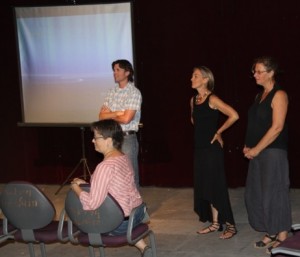
May 19, 2014 | Blog

Filmmaker Ben Johnson, Director Kimi Eisele and Composer Vicki Brown fielding questions.
The Patagonia Area Resource Alliance hosted a reception and screening of ‘Rosemont Ours’ in Patagonia on Saturday, May 17. The evening began with a reception at Molly’s Studio Patio followed by a screening of “Rosemont Ours,” a film of modern dance celebrating the plants and animals of the Santa Rita Mountains. Filmmaker Ben Johnson, Director Kimi Eisele and Composer Vicki Brown were on hand to introduce the film and answer questions. “Rosemont Ours” was born in response to the proposed construction of the Rosemont Mine. By “replacing” plants and animals with human beings in reverential and playful ways, the film invited us to consider our role as both stewards and consumers of nature. “Rosemont Ours” can be viewed online: http://rosemontours.com/the-video/
PARA board member, Carolyn Shafer also spoke to the audience providing an update to PARA’s activities, introducing the PARA board and thanking the community for their ongoing support. These are her words:
 The real wealth of a community is measured by its inhabitants – human, plant and animal. Our community is very wealthy. Our abundance is the water and air and land that has supported life in this region for many thousands of years. We all need to be involved in protecting our natural resources from further degradation and to regenerate our region’s habitat to better support our biodiversity. And that is the essence of Patagonia Area Resource Alliance’s mission statement.
The real wealth of a community is measured by its inhabitants – human, plant and animal. Our community is very wealthy. Our abundance is the water and air and land that has supported life in this region for many thousands of years. We all need to be involved in protecting our natural resources from further degradation and to regenerate our region’s habitat to better support our biodiversity. And that is the essence of Patagonia Area Resource Alliance’s mission statement.
Many of you here tonight help in this cause through your financial support which is deeply appreciated – some day we won’t have to ask for ongoing support but that day has not yet arrived. Some of us are able to give our time to this work and I’d like to introduce you to our Board and staff: Michael Stabile, Gooch Goodwin, Joe Nitche and not able to be here tonight: Cliff Hirsch, Kati Ballard, Lee Rogers. Our staff: Coordinator Wendy Russell and Social Media Outreach Colin Treiber.
In addition to help fund these efforts, writing comments is also appreciated including those recently submitted on the Wildcat Silver Hermosa drilling proposal. The next step will be the release by the Forest Service of the Final Environmental Assessment and the Draft Decision expected to be made public in June or July. That will open a 45 day Objection Period. If you commented on the Hermosa drilling proposal during a public comment period, you are eligible to participate in the objection process.
PARA is strategically creating alliances with other organizations. It is a gratifying experience to introduce representatives from these organizations to our corner of the cosmos. It is not an understatement to say that they fall in love with our area and value its unique biodiversity and want to assist in protecting the Patagonia Mountains.
-PARA coordinated a Coalition of International, Regional and Local Organizations to comment on the Forest Service Draft Environmental Assessment for the Hermosa drilling proposal. Those organizations are the Arizona Mining Reform Coalition, Center for Biological Diversity, Defenders of Wildlife, Earthworks, and Sky Island Alliance.
-We hosted the Defenders of Wildlife Southwest Office and legal team for a 2 day tour of proposed mine sites in the Patagonia Mountains.

WMAN conference participants from L: Roy Chavez, Concerned Citizens and Retire Miners Coalition; Wendy Russell, PARA; Aaron Mintzes, Earthworks; Lauren Pagel, Earthworks; and Roger Featherstone, AZ Mining Reform Coalition.
-Through a generous scholarship program, PARA Coordinator Wendy Russell attended the Western Mining Action Network (WMAN) conference on May 9-10, 2014 in Anchorage, Alaska. WMAN provides a critical forum for communities facing mining in the United States and Canada. Their conference provides an excellent venue for information sharing, networking, learning, and strategizing among organizations and individuals working to reduce the negative environmental and social impacts of mining.
-PARA has teamed with Earthworks to develop an independent, peer-reviewed study of the potential impacts of Wildcat Silver’s open pit mine on our groundwater, the potential for acid drainage contamination, heavy metals pollution, as well as the range of issues associated with air pollution, light and noise pollution.
Why do any of us give our time and our money for this cause? I think a quote from scientist David Suzuki summarizes the core motivation for each of us: “There are some things in the world we can’t change–gravity, entropy, the speed of light, and our biological nature that requires clean air, clean water, clean soil, clean energy and biodiversity for our health and well being. Protecting the biosphere should be our highest priority or else we sicken and die.”
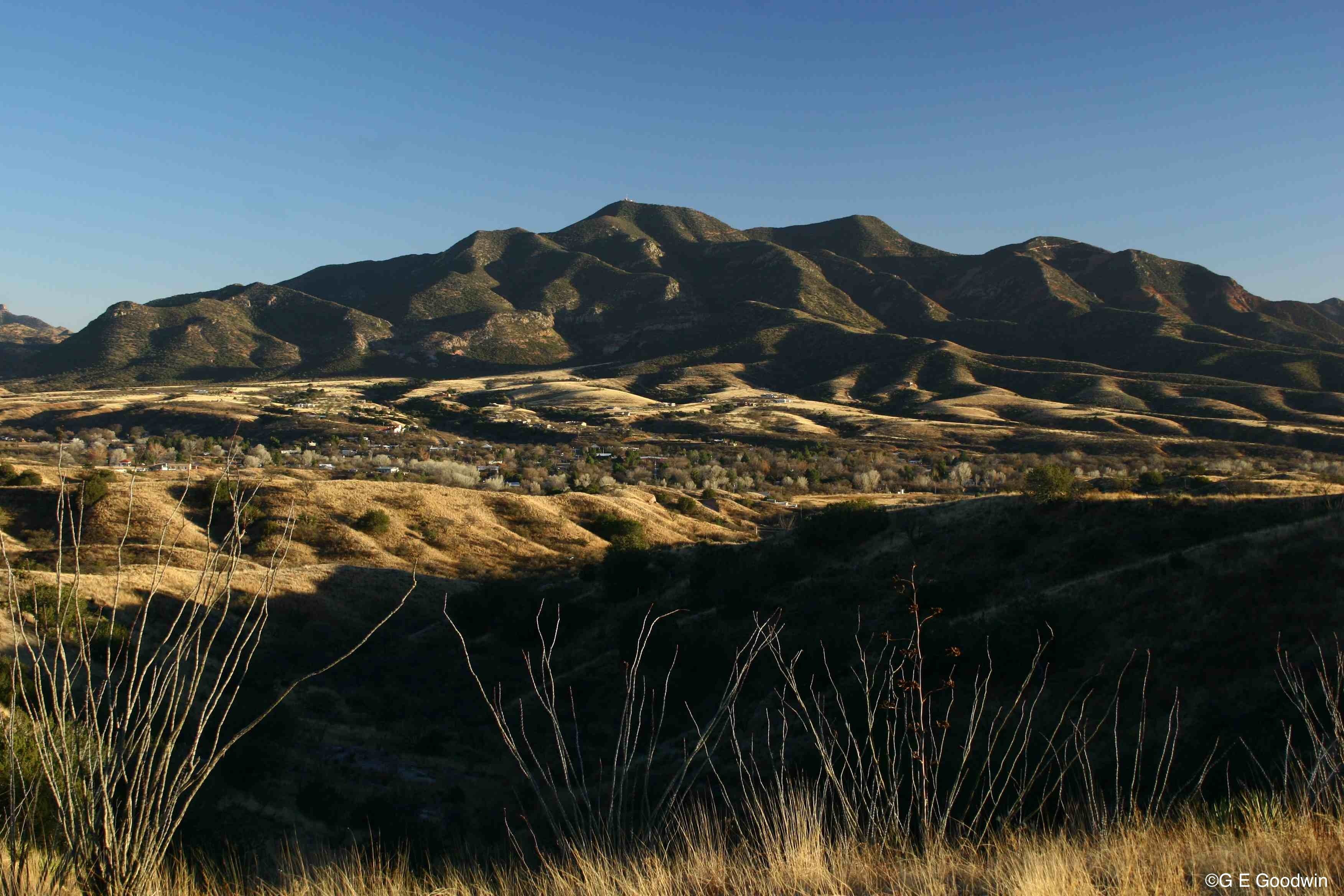
May 17, 2014 | Blog
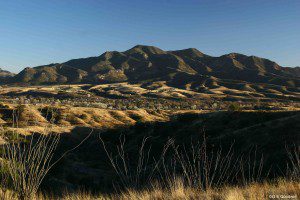
May 1, 2014 | Blog
By Carolyn Shafer
It is critical that we as individuals, our governing bodies and our community organizations mindfully support existing businesses and invite new business activity that will create a stable and sustainable economy and provide livelihood to all who are willing to work. Let’s first consider some historical and economic information.
The longest lasting local economic activity in the Patagonia area during the last four centuries has been ranching, a part of the economy even now. As prospecting in the 19th and 20th centuries found major mineral deposits, there has also been two boom-and-bust periods of mining, from about 1860-1910 and again in the middle 20th century. The last mine near Patagonia closed in 1965.
 In the 50 years since the last mining bust, the community has rebuilt its local economy based on ranching, tourism, local food production and recreational amenities (birding, hunting, camping, cycling, hiking, etc).
In the 50 years since the last mining bust, the community has rebuilt its local economy based on ranching, tourism, local food production and recreational amenities (birding, hunting, camping, cycling, hiking, etc).
How did the local economy perform under the industrial based economy (predominantly mining) and under the service based economy (predominantly tourism)? A review of all available Town of Patagonia financial audits (1963-2013) helps quantify a half century of economic transformation for the Town of Patagonia. Sales tax revenue is one measurement of the town’s financial health. In 1963, the Town’s sales tax revenues in comparable 2013 dollar value was $54,311 (actual revenue was $7,191). In 2013, the Town’s sales tax revenue was $197,540. The service based economy (predominantly tourism) in 2013 provided 364% more sales tax revenue than the predominantly mining industrial based economy. Another measure of the town’s health is population, the town’s population grew from 540 in 1960 to 913 in 2013 – a growth of 69% under the service based economy.
I am one of the owners of the local artists gallery. Our business represents more than 40 area artists. 85% of our business is from visitors to the Patagonia Mountains who come here to enjoy birding, hunting, camping, cycling, hiking and other outdoor recreational activities. I believe that my business and almost all of the existing businesses will be destroyed as the result of new mining in our mountains. The existing, local jobs that will be lost will exceed any mining jobs that might be created for local people. Yes, there is a history of mining in this area. I know that there are families in our community who were part of that mining tradition. Historic mining put food on the table and provided a living for many local families. Those historic mines and jobs are of an entirely different time and place than would exist with today’s mining practices.
What can we as a community do now to proactively create a stable local economy? I propose that we create a discussion group that includes all businesses as well as community organizations and interested individuals. A few of the topics include a look at the factual information available about the current employment situation, the history of this area’s economic stability and success under both the industrial and the service based economies, discussions about how we can support our existing businesses, and determine how we attract new businesses that will contribute to this thriving, resilient community. I hope to enlist local business owners and community organizations to participate in such a discussion so that we can work together as a community to establish a plan that truly perpetuates a strong and sustainable economy. I will first reach out to the Patagonia Area Business Association and the newly formed Patagonia Regional Business Coalition as two organizations that represent various business interests in the community.
Please share your suggestions for economic development and local employment. My contact information is in the Country Connection.
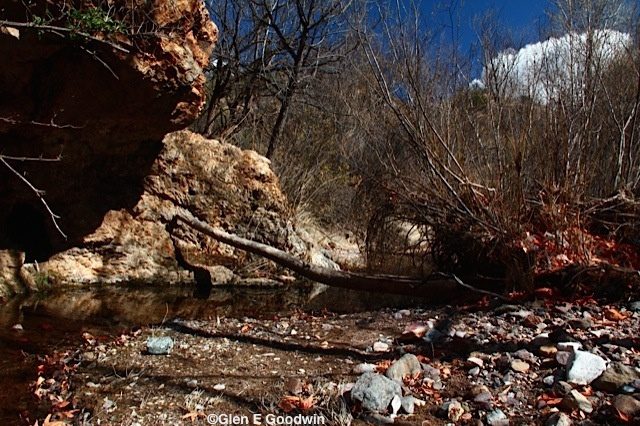
Apr 25, 2014 | Blog

Apr 25, 2014 | Blog
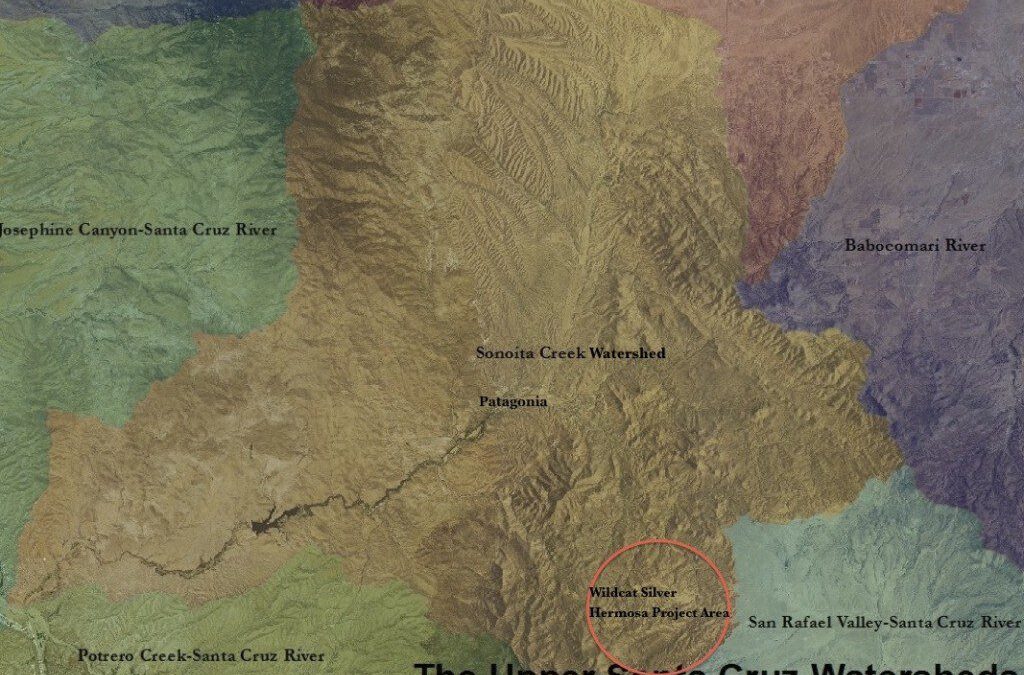
Apr 8, 2014 | Blog
By Bryan Junger
As a citizen of Patagonia and environmental engineer, I got a real kick out of Greg Lucero’s opinion piece published March 19 in The Bulletin, entitled Town Water Supply: Fact vs. Fiction. As the title suggests, this piece is chock full of fiction, but I was unable to positively identify a single fact, other than Lucero’s name and title. I enjoy active reading, so trying to figure out which (if any) of Lucero’s statements were actually true was a welcomed exercise.
The first false statement Lucero makes is about the designation of Sonoita Creek Watershed as a “municipal” watershed, an issue that Jim Upchurch Forest Supervisor from the Coronado National Forest put to rest at a public meeting in Patagonia on March 24, 2014. Upchurch told Patagonia citizens that the Forest Service already considers Sonoita Creek to be a municipal watershed.
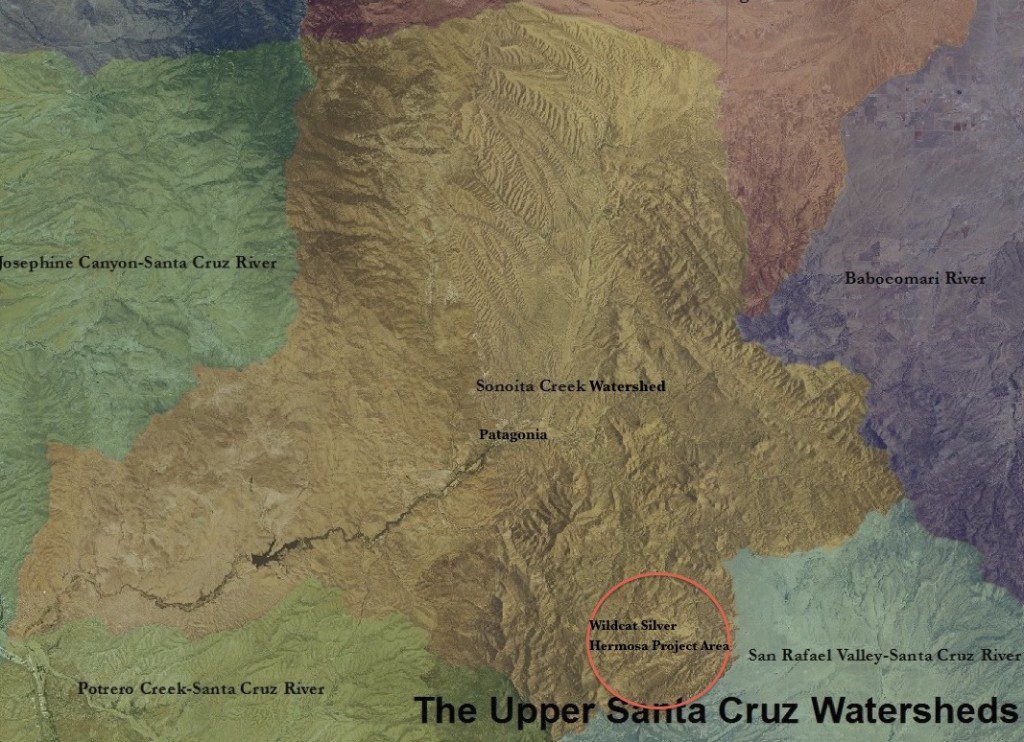
The municipal watershed designation may not preclude the use of Forest Service land for mining, as it is authorized by the US Mining Laws of May 10, 1872. These laws secure a “free entry” system forged under a frontier mentality, from a time when mining was the “first and best use of the land,” though these laws have since been modified to include amendments for the provision of “sound environmental practices.”
As VP of Sustainability for AZ Mining Inc / Wildcat Silver, I can only presume that Mr. Lucero is at least partially responsible for ensuring that his company operates according to sound environmental practices. Judging from the statements made in his recent article about our town’s water supply, we might assume that Mr. Lucero has a background in environmental analysis, hydrology, geology, or perhaps some form of engineering. The fact is, Mr. Lucero holds a B.A. in Political Science from the University of Arizona and has worked primarily in management positions throughout his career. By no measure does he appear to be an expert of hydrology, geology, environmental science, or related fields.
Two of the assertions made in Mr. Lucero’s article are the most glaringly inaccurate, in my mind:
- There is no hydrogeologic data to support the assertion that Harshaw Creek is located in the headwaters of Sonoita Creek watershed, feeding into the Town of Patagonia’s municipal water supply. This statement is plainly untrue. There is significant data available for the Sonoita Creek watershed, most of which has been produced by scholars and researchers associated with Mr. Lucero’s alma mater, the University of Arizona. U of A has a world-class hydrology department and has conducted numerous studies of the Sonoita Creek Watershed over the last 40+ years. Multiple studies provide evidence suggesting that a portion of the water flowing in and below Sonoita Creek – the source of Patagonia’s municipal water supply – are sourced from the Patagonia Mountains, which includes the area near Harshaw Creek.
- Patagonia’s wells and associated hydrogeology are different, the wells draw from a different source, and the location is 1,000 feet higher in elevation so therefore it is disconnected. While Lucero refers to an unnamed study by the AZ Department of Water Resources, the fact is that this statement about groundwater sourcing is pure conjecture. Harshaw is located within Sonoita Creek Watershed, at a higher elevation than the town of Patagonia but draining to the same location – the confluence where Sonoita Creek enters the Santa Cruz River. Therefore, by definition, this old mining town is located within the headwaters of both Sonoita Creek and the Santa Cruz River. Harshaw is both higher in elevation and located along the Harshaw Creek drainage that feeds into Sonoita Creek. It is located East of Patagonia and the local topology dictates that in order for water originating at Harshaw to drain into the Santa Cruz several miles West, it must flow down-gradient into Sonoita Creek.
In an effort to help combat misinformation about our watershed and also to work toward responsible management and improvement, local citizens and stakeholder groups are in the process of forming a Watershed Improvement Council (WIC) as part of an effort to consider our watershed, its health, and its many uses carefully so that we can continue to enjoy its services in perpetuity. If you are interested in learning more or becoming involved, please send me a message at bryan.jungers@gmail.com.
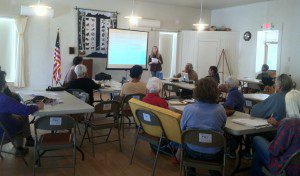
Mar 27, 2014 | Blog
PARA, Jenny Neeley and Sergio Avila from Sky Island Alliance teamed up again to host a NEPA comment workshop at Cady Hall in Patagonia on March 26, 2014. Discussed were the potential issues of the Forest Service’s Draft Environmental Assessment of the AZ Mining Inc / Wildcat Silver / Arizona Minerals Hermosa mining exploration proposal and how to comment effectively on it.
 Jenny Neeley reprised her role as our National Environmental Policy Act (NEPA) expert for tips on filing public comments on the Hermosa draft Environmental Assessment (EA) released by the Coronado National Forest. The purpose of an Environmental Assessment is to determine whether the impacts of a project will be significant. The goal for our comments on the draft EA is to demonstrate that the Hermosa project impacts will be significant so that the Forest Service conducts a more detailed and comprehensive Environmental Impact Statement. Read more tips for writing comments here.
Jenny Neeley reprised her role as our National Environmental Policy Act (NEPA) expert for tips on filing public comments on the Hermosa draft Environmental Assessment (EA) released by the Coronado National Forest. The purpose of an Environmental Assessment is to determine whether the impacts of a project will be significant. The goal for our comments on the draft EA is to demonstrate that the Hermosa project impacts will be significant so that the Forest Service conducts a more detailed and comprehensive Environmental Impact Statement. Read more tips for writing comments here.
PARA board member Cliff Hirsch gave a summary of the expected activities proposed by the AZ Mining Inc / Wildcat Silver / Arizona Minerals Hermosa exploratory drilling project located 6 miles southeast of the Town of Patagonia. The project activities encompasses 7350 acres of both Coronado National Forest and private land. It is also expected to use 3,525,800 gallons of groundwater pumped from within the Town of Patagonia Municipal Supply Watershed. Click here for talking points and Hermosa project summary.

SIA Biologist, Sergio Avila
SIA biologist Sergio Avila discussed the amazing biodiversity found in the Patagonia Mountains during the Bioblitz event conducted in April 2013. View the Bioblitz report here. The results from the Bioblitz and the ongoing wildlife tracking in the Patagonia Mountains demonstrate the importance of the Patagonias as a wildlife corridor and biological hotspot in the sky island mountain ranges of southern Arizona and northern Mexico. Click for a list of Federally Threatened, Endangered and Sensitive Species in the Patagonia Mountains of the Coronado National Forest in southern Arizona.
The Hermosa draft Environmental Assessment is available at the Patagonia Public Library and online at the Forest Service website on the Hermosa project page: http://www.fs.fed.us/nepa/nepa_project_exp.php?project=41158.
Thank you everyone for your participation. The Forest Service received 200 public scoping comments on the Hermosa Plan of Operation. Let’s send them 200 more on the draft EA! Deadline to submit comments is Friday, April 11, 2014.
Additional Resources:
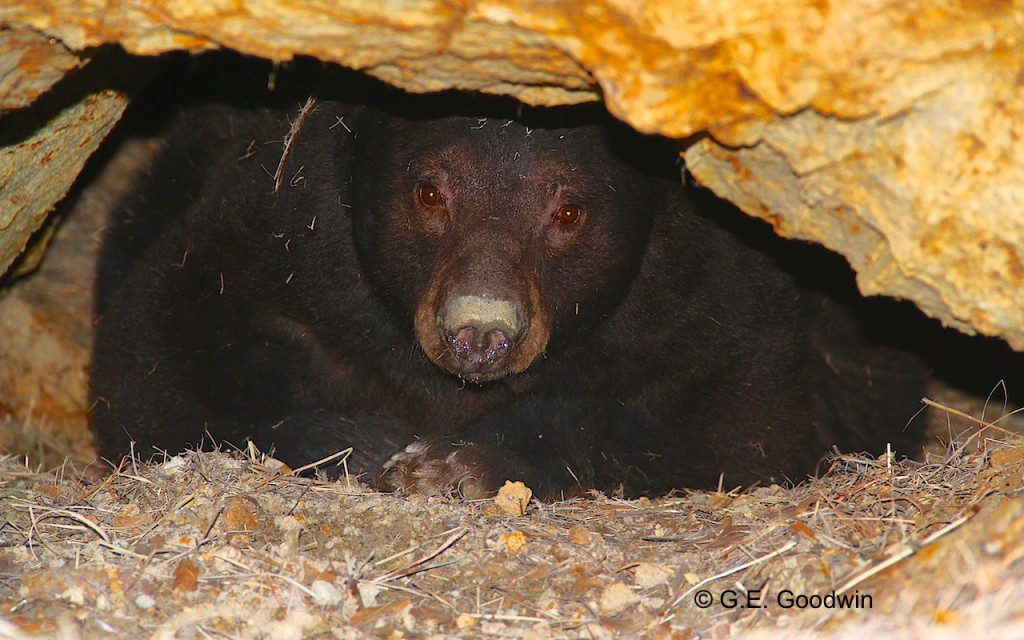
Save my home in the Patagonia Mountains. ©Gooch Goodwin
Mar 27, 2014 | Blog
Tips for Writing Comments for a Draft EA
By Jenny Neeley
1. Consider whether the effects significant. If they are, then the Forest Service must prepare a more detailed Environmental Impact Statement (EIS) rather than an Environmental Assessment (EA). When deciding whether the impacts are “significant” NEPA implementing regulations (40 CFR § 1508.27) require that agencies consider both:
- Context: The significance of an action must be analyzed in several contexts such as society as a whole, the affected region, the affected interests, and the locality. Significance varies with the setting of the proposed action. For instance, in the case of a site-specific action, significance would usually depend upon the effects in the locale rather than in the world as a whole. Both short- and long-term effects are relevant.
- Intensity: This refers to the severity of impact. …The following should be considered in evaluating intensity:
- Impacts that may be both beneficial and adverse. A significant effect may exist even if the Federal agency believes that on balance the effect will be beneficial.
- The degree to which the proposed action affects public health or safety.
- Unique characteristics of the geographic area such as proximity to historic or cultural resources, park lands, prime farmlands, wetlands, wild and scenic rivers, or ecologically critical areas.
- The degree to which the effects on the quality of the human environment are likely to be highly controversial.
- The degree to which the possible effects on the human environment are highly uncertain or involve unique or unknown risks.
- The degree to which the action may establish a precedent for future actions with significant effects or represents a decision in principle about a future consideration.
- Whether the action is related to other actions with individually insignificant but cumulatively significant impacts. Significance exists if it is reasonable to anticipate a cumulatively significant impact on the environment. Significance cannot be avoided by terming an action temporary or by breaking it down into small component parts.
- The degree to which the action may adversely affect districts, sites, highways, structures, or objects listed in or eligible for listing in the National Register of Historic Places or may cause loss or destruction of significant scientific, cultural, or historical resources.
- The degree to which the action may adversely affect an endangered or threatened species or its habitat that has been determined to be critical under the Endangered Species Act of 1973.
- Whether the action threatens a violation of Federal, State, or local law or requirements imposed for the protection of the environment.
2. Make your comments “substantive” and specific. The Forest Service is required by law to respond to all “substantive” comments submitted during the public comment period; the more specific and focused your comments are, the more detailed the response must be from the agency. Comments that simply say “I am opposed to this project” will not, by themselves, require a response from the agency.
3. Include the specific sections, pages and/or topics you are referencing in the Draft EA. To the extent you can, direct your comments to specific sections, pages or topics in the Draft EA, recognizing that some comments may be addressing missing or incomplete information, or even missing topics, that you feel should be addressed.
4. Make your letter personal! Your personal connection to the Patagonia Mountains and surrounding area is an incredibly important part of your comment letter. You should explain how will you be personally impacted if this proposal moves forward. Include information about how it will affect your home, your land, your family, and/or your business and livelihood. This is a great way to start your letter and to frame the rest of your comments, and will help get the Forest Service’s attention.
Additional Information
See our NEPA Resources page: http://www.patagoniaalliance.org/nepa-resources/
More information about Wildcat Silver at: http://www.patagoniaalliance.org/wildcat-silver/





 Test results showed off-the-chart concentrations of lead and arsenic in water, soil and waste rock samples at the Lead Queen site. High concentrations of zinc, copper and aluminum were also found. All of these heavy metals are listed as “hazardous substances” and can cause serious – or even deadly – health issues. The red-orange color of the sludge was due to extreme concentrations of iron.
Test results showed off-the-chart concentrations of lead and arsenic in water, soil and waste rock samples at the Lead Queen site. High concentrations of zinc, copper and aluminum were also found. All of these heavy metals are listed as “hazardous substances” and can cause serious – or even deadly – health issues. The red-orange color of the sludge was due to extreme concentrations of iron. The Forest Service document also acknowledges that the “Patagonia Mountains have high levels of biodiversity and are home to a variety of species protected under the Endangered Species Act including jaguar, ocelot, lesser long-nosed bat, Mexican spotted owl, western yellow-billed cuckoo, Sonora tiger salamander, and the northern Mexican gartersnake.”
The Forest Service document also acknowledges that the “Patagonia Mountains have high levels of biodiversity and are home to a variety of species protected under the Endangered Species Act including jaguar, ocelot, lesser long-nosed bat, Mexican spotted owl, western yellow-billed cuckoo, Sonora tiger salamander, and the northern Mexican gartersnake.”












 Patagonia – The Hermosa silver mine proposed inside Patagonia, Arizona’s Municipal Supply Watershed could deplete the town’s drinking water and perpetually contaminate area groundwater with acid mine drainage, according to a new peer-reviewed report.
Patagonia – The Hermosa silver mine proposed inside Patagonia, Arizona’s Municipal Supply Watershed could deplete the town’s drinking water and perpetually contaminate area groundwater with acid mine drainage, according to a new peer-reviewed report.
 The western population of the yellow-billed cuckoo (Coccyzus americanus), an insect-eating bird found in riparian woodland habitats, winters in South America and breeds in western North America. Once abundant in the western United States, populations have declined for several decades, primarily due to the severe loss, degradation and fragmentation of its riparian habitat as a result of conversion to agriculture, dam construction, river flow management and riverbank protection. Overgrazing and invasive exotic plants have also contributed to declines.
The western population of the yellow-billed cuckoo (Coccyzus americanus), an insect-eating bird found in riparian woodland habitats, winters in South America and breeds in western North America. Once abundant in the western United States, populations have declined for several decades, primarily due to the severe loss, degradation and fragmentation of its riparian habitat as a result of conversion to agriculture, dam construction, river flow management and riverbank protection. Overgrazing and invasive exotic plants have also contributed to declines.











 The real wealth of a community is measured by its inhabitants – human, plant and animal. Our community is very wealthy. Our abundance is the water and air and land that has supported life in this region for many thousands of years. We all need to be involved in protecting our natural resources from further degradation and to regenerate our region’s habitat to better support our biodiversity. And that is the essence of Patagonia Area Resource Alliance’s mission statement.
The real wealth of a community is measured by its inhabitants – human, plant and animal. Our community is very wealthy. Our abundance is the water and air and land that has supported life in this region for many thousands of years. We all need to be involved in protecting our natural resources from further degradation and to regenerate our region’s habitat to better support our biodiversity. And that is the essence of Patagonia Area Resource Alliance’s mission statement. 


 In the 50 years since the last mining bust, the community has rebuilt its local economy based on ranching, tourism, local food production and recreational amenities (birding, hunting, camping, cycling, hiking, etc).
In the 50 years since the last mining bust, the community has rebuilt its local economy based on ranching, tourism, local food production and recreational amenities (birding, hunting, camping, cycling, hiking, etc).







 Jenny Neeley reprised her role as our National Environmental Policy Act (NEPA) expert for tips on filing public comments on the Hermosa draft Environmental Assessment (EA) released by the Coronado National Forest. The purpose of an Environmental Assessment is to determine whether the impacts of a project will be significant. The goal for our comments on the draft EA is to demonstrate that the Hermosa project impacts will be significant so that the Forest Service conducts a more detailed and comprehensive Environmental Impact Statement.
Jenny Neeley reprised her role as our National Environmental Policy Act (NEPA) expert for tips on filing public comments on the Hermosa draft Environmental Assessment (EA) released by the Coronado National Forest. The purpose of an Environmental Assessment is to determine whether the impacts of a project will be significant. The goal for our comments on the draft EA is to demonstrate that the Hermosa project impacts will be significant so that the Forest Service conducts a more detailed and comprehensive Environmental Impact Statement. 
